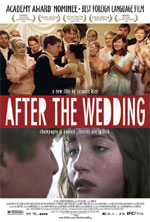Film Reviews ....
Characters Collide After the Wedding
By Elaine Radford
After the Wedding, a Danish film directed by Susanne Bier, has all the elements of a richly-crafted, complex drama. Set in both the squalid slums of Bombay, India, and the wealthy environs of upper class Copenhagen, the film portrays a struggle for survival as characters play out their lives at opposite ends of society.
After the Wedding offers many messages for audiences to ponder, but the main conflict is derived from one theme. The theme shows that even though the lives of the poorest and most vulnerable depend on the generosity of the rich, wealth itself cannot assure the survival of the wealthy. Conflict is created when characters influenced by different cultures collide.
Jacob Peterson (Mads Mikkelsen), the protagonist (hero), is a Danish man living in India. He has dedicated his life to helping orphans in India but is dependent on Danish aid to maintain an orphanage. He travels to Copenhagen on a mission to secure funds for the orphanage from Jørgen (Rolf Lassgård), a wealthy businessman who insists on meeting him.
Jacob plans to return to India within a few weeks, but he soon finds his life manipulated. Jørgen prevents him from leaving Denmark by making one demand after another, ensnaring Jacob in his family’s life. First, Jørgen insists that Jacob attend his daughter’s wedding, where he meets Helene (Sidse Babett Knudsen), Jørgan’s wife and Jacob’s former lover.
The stage is now set for conflict. And the pace quickens as secrets are exposed at the wedding reception, spinning the drama in a new direction. Events happen quickly after the wedding, as Jacob clashes with Jørgan and Helene and destinies are changed forever.
As the layers of each character peal away, their relationships with each other evolve into something entirely unexpected and complex. Jørgen’s wife and daughter become new obstacles that impede Jacob’s return to India.
A confrontation between Jacob and Jørgen sends Jacob into a rage. He is more determined than ever to return to his beloved orphanage. But a new obstacle, more important than his own personal needs, keeps him from leaving Denmark again. And in a climactic scene, we finally understand Jørgen’s motivation for keeping Jacob in Denmark.
The scenes move back and forth between India and Copenhagen, but the pace never lags as screenwriter Anders Thomas Jensen skillfully reveals the characters’ motivations and moves the story toward the climax and resolution. One can see why After the Wedding received a 2006 Academy Award nomination for Best Foreign Language Film. This film successfully shows how the collision of two cultures can create drama and help us understand people.
To write a screenplay in which characters influenced by different cultures collide, ask yourself several questions:
1. Who is the protagonist? What’s his goal? How does his background
determine how he chooses a goal? Describe his background and how it
differs from that of the antagonist.
2. What obstacles does the protagonist face in reaching his goal? How does the
antagonist create those obstacles?
3. When does the story take place in time? What role does the time period play in
the main conflict of the story?
4. Where does the story take place? Does it move from one geographic
location to another? What role do the different locations play in the main
conflict?
5. Why do the protagonist’s actions determine how he achieves his goal? How do
his unique characteristics influence his actions?

